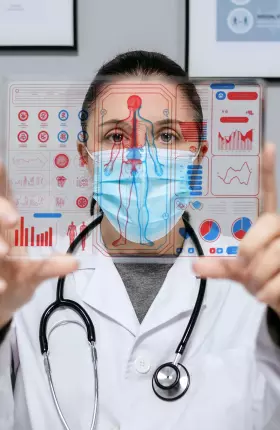AI is already beginning to transform public services—streamlining processes, saving costs, and empowering workers to deliver on rising citizen expectations.
Economic Development

Article
March 25, 2025
The digital euro could transform Europe’s economy. But unlocking its full potential requires vision, the right governance structure, and a robust digital ecosystem.

Report
November 20, 2024
BCG’s new AI Maturity Matrix combines an economy’s exposure to AI with its readiness to handle AI disruption. Explore our assessment of 73 economies.

Article
September 30, 2024
Governments that engage in strategic cost optimization can recoup 10% of costs—or more—on a whole-of-government basis using existing tools.

Article
July 2, 2024
A well-designed digital euro could enhance Europe’s monetary sovereignty, maintain accountability and safety, reduce cost and risk of cross-border transactions, and foster innovation across industries.

Article
May 10, 2024
Governments have two key strategies—evolving existing economic clusters to remain competitive and capitalizing on emerging opportunities—to help economic clusters rapidly adapt to the green transition.
Defense and Security

Article
October 22, 2025
A C$1.2 trillion boost in military spending over the next decade can be a catalyst for growth and innovation across Canada’s industrial base.

Article
October 21, 2025
As militaries invest heavily in new technology, they need to launch a similar effort to give armed forces and civil servants the capabilities to succeed with new tools.

Article
April 8, 2025
Governments around the world are increasing their defense spending, but a new approach, Mission-Based ROI™, can help ensure that they get the maximum impact from new investments.

Article
June 19, 2025
With the sector entering a new era, this report outlines how governments can maximize benefits and manage risks to take advantage of Space 4.0.

Report
February 11, 2025
To improve innovation, defense ministries must confront a number of issues that pose outsized constraints but are not fully understood, appreciated, or addressed.

Article
March 4, 2025
As geopolitical tensions rise, defense ministries, manufacturers, and other stakeholders must become more agile and proactive.
Weekly Insights Subscription
Stay ahead with BCG insights on the public sector
Digital Government

Article
October 24, 2025
By taking a customer-centric approach, departments of motor vehicles can shed their longstanding reputation for poor service.

Article
September 17, 2025
The risks for governments are already high. But the rapid growth of AI has raised the stakes even further by giving attackers new, faster, and more effective hacking tools.

Article
May 8, 2025
AI is already beginning to transform public services—streamlining processes, saving costs, and empowering workers to deliver on rising citizen expectations.
Video
Transforming Public Services with AI
By strengthening the digital public infrastructure, AI can help make public services more effective. Robert Opp of United Nations Development Programme and BCG’s Maikel Wilms discuss how.

Article
October 16, 2024
As the government rethinks its approach to digitization, public sector organizations are working in agile and transparent ways to create a better and more flexible technology architecture.

Article
March 26, 2024
We highlight six key enablers that can help the public sector unlock the transformative benefits of Generative AI for their organizations and communities.
Education, Employment, and Welfare

Article
July 23, 2025
For higher education institutions, the question is no longer whether change is needed, but how fast can institutions make it happen.

Article
March 26, 2024
Costly or cost-effective? Recent BCG research finds that childcare benefits deliver returns of up to 425% of their cost for companies across the US.

Article
March 22, 2024
Experts anticipate that jobs will blossom over the next 50 years—even as technology becomes more prevalent and climate challenges persist.

Talent can be hard to source and retain, even as segments of the US population lack access to satisfying, supportive jobs. Three initiatives are making a difference.
Health Care Systems

While digital, data, and AI have extraordinary potential to revolutionize our global health care systems, they have yet to deliver a transformative impact. How can the public and private sectors accelerate progress?

Discover the transformative power of Generative AI in the healthcare sector. Public sector organizations play a crucial role in leveraging and enabling AI for improved operations, mission acceleration, and responsible adoption strategies.

Article
August 17, 2023
A business-led approach to strategy and management of large-scale technology projects can help agencies move faster and achieve better results.

Article
August 9, 2023
As the youth mental health crisis in the US continues to worsen, a new report from the National Governors Association, in collaboration with BCG, offers a path forward for state leaders.
Green Economy
Video
March 6, 2025
Green Economy: The Opportunity and the Trade-Offs

Article
February 19, 2025
Transitioning to green energy creates a healthier planet while providing countries with job growth and greater energy security. However, governments will have to make many policy tradeoffs.

Article
January 16, 2025
Addressing climate change is creating opportunities that may be worth $11 trillion by 2040. Countries that act early can position themselves for growth.

Article
January 23, 2025
To seize the economic opportunity presented by the global green transition, policymakers need to concentrate on the following principal levers and key success factors.
Infrastructure

Article
December 4, 2025
By looking beyond initial construction bids to the total cost of ownership—including operations, maintenance, and other factors—infrastructure owners can save billions of dollars over the life of their assets.

Article
October 28, 2024
Congestion, accidents, emissions, and other challenges require cities to develop holistic mobility alternatives that will shift travel from private transport to public and active modalities.

Article
March 25, 2025
For infrastructure players, addressing ecosystem degradation can unlock business opportunities, foster innovation, and enhance their competitive advantage.

Article
December 14, 2023
Governments can embrace the success of so-called smart cities, such as London and Riyadh, to promote and fund digital services in their countries.

Article
December 6, 2023
The time for urgent adaptation and resilience efforts for the world’s land transport infrastructure is now.
How are governments transforming lives and achieving positive impact? Explore our interviews, articles, briefing bulletins, and podcasts from around the world.

Canada’s Plan for Achieving Its Ambitious Climate Change Agenda
Joerg Hildebrandt
-
 Canada’s Plan for Achieving Its Ambitious Climate Change Agenda
Canada’s Plan for Achieving Its Ambitious Climate Change Agenda Canada’s Plan for Achieving Its Ambitious Climate Change Agenda
Canada’s Plan for Achieving Its Ambitious Climate Change AgendaJoerg Hildebrandt
-
 Digital in the Public Sector
Digital in the Public Sector Digital in the Public Sector
Digital in the Public Sector -
 How Governments Can Restructure to Better Serve Citizens
How Governments Can Restructure to Better Serve Citizens How Governments Can Restructure to Better Serve Citizens
How Governments Can Restructure to Better Serve Citizens -
 The Future of Work Is the Future of Education
The Future of Work Is the Future of Education The Future of Work Is the Future of Education
The Future of Work Is the Future of Education -
 Government Service Is Customer Service
Government Service Is Customer Service Government Service Is Customer Service
Government Service Is Customer Service -
 How Governments Can Overcome the Challenge of Providing More For Less
How Governments Can Overcome the Challenge of Providing More For Less How Governments Can Overcome the Challenge of Providing More For Less
How Governments Can Overcome the Challenge of Providing More For Less
Explore more
Industry
Industry









